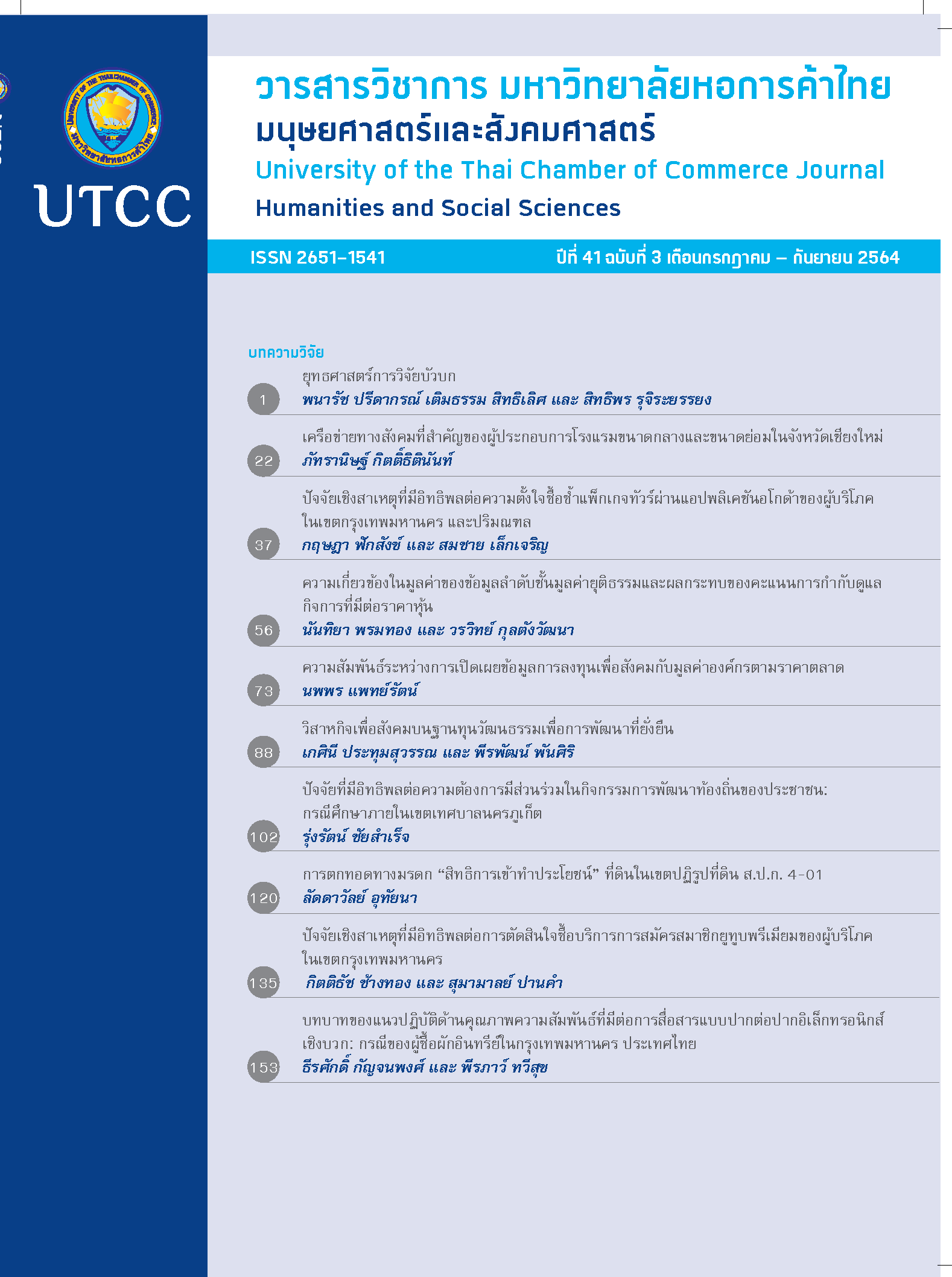The Influence of Causal Factors on Package Tour Repurchase Intention via Agoda Application of Consumers in Bangkok and Its Vicinity
Main Article Content
Abstract
The objective of this research was to 1) study the causal factors influencing consumers repurchase intention for package tour on Agoda Application in Bangkok and its vicinity and to
2) develop and to validate the consistency of a causal relationship modal of consumers repurchase intention for package tour on Agoda Application. The tools used in the research was online questionnaires. The sample group consisted of 215 people who have been repurchase package tour on Agoda Application and who have lived in Bangkok and its vicinity. The statistics used in data analysis were frequency, percentage. The structural equation model is used to analyze causal relationships to find the path to the causal influence. The result of the research showed that the causal relationship model was developed of 4 components were 1) perceived service quality
2) perceived value 3) satisfaction and 4) repurchase intention and accordance with empirical data consisting. The final was predictive coefficient of 0.80, indicating that the variables in the model can explain the variance of the consumers repurchase intention for package tour on Agoda Application by 80 percent. This research found that the satisfaction services were the most influence on direct effect consumers repurchase intention and the perceived service quality were the most influence on indirect effect consumers repurchase intention for package tour on Agoda Application in Bangkok and its vicinity.
Article Details

This work is licensed under a Creative Commons Attribution-NonCommercial-NoDerivatives 4.0 International License.
ลิขสิทธิ์ของบทความ
ผลงานที่ได้รับการตีพิมพ์ถือเป็นลิขสิทธิ์ของมหาวิทยาลัยหอการค้าไทย ห้ามมิให้นำเนื้อหา ทัศนะ หรือข้อคิดเห็นใด ๆ ของผลงานไปทำซ้ำ ดัดแปลง หรือเผยแพร่ ไม่ว่าทั้งหมดหรือบางส่วนโดยไม่ได้รับอนุญาตเป็นลายลักษณ์อักษรจากมหาวิทยาลัยหอการค้าไทยก่อน
References
กริช แรงสูงเนิน. (2554). การวิเคราะห์ปัจจัยด้วย SPSS AMOS เพื่อการวิจัย. กรุงเทพฯ: ซีเอ็ดยูเคชั่น.
คุลิกา วัฒนสุวกุล. (2555). ปัจจัยส่วนประสมทางการตลาดที่มีอิทธิพลต่อพฤติกรรมการซื้อความพึงพอใจและความตั้งใจซื้อซ้ำของลูกค้า: กรณีศึกษาแผนกยาของร้านวัตสัน (วิทยานิพนธ์ปริญญามหาบัณฑิต, มหาวิทยาลัยศรีนครินทรวิโรฒ). สืบค้นจาก http://thesis.swu.ac.th/swuthesis/Mark/Kulika_W.pdf
ชนิกา ลักขณาศิริวัตร. (2560). อิทธิพลของคุณค่าที่รับรู้ด้านราคา และคุณภาพระบบ ต่อการใช้งาน ความพึงพอใจ การกลับมาซื้อซ้ำและการบอกต่อของลูกค้าที่จองที่พักผ่านผู้ให้บริการเว็บไซต์ในประเทศไทย (การค้นคว้าอิสระปริญญามหาบัณฑิต, มหาวิทยาลัยกรุงเทพ). สืบค้นจาก http://dspace.bu.ac.th/jspui/handle/123456789/3405
ชไมพร กาญจนกิจสกุล. (2555). ระเบียบวิธีวิจัยทางสังคมศาสตร์. ตาก: โพรเจ็คท์ไฟฟ์-โฟว์.
Shopback. (2563, กันยายน). 7 แอป-เว็บจองที่พัก อัปเดต 2020 ที่สายเที่ยวควรลิสต์เก็บไว้ [บล็อก]. สืบค้นจาก https://www.shopback.co.th/blog/จองโรงแรม/
ณัฐพล ม่วงทำ. (2563). วิเคราะห์ Digital Thailand 2020 We Are Social เป็นอย่างไรเมื่อเทียบกับ 2019. สืบค้นเมื่อ 6 ตุลาคม 2563, จาก https://www.everydaymarketing.co/trend-insight/digital-thailand-2020-we-are-social/
นวลอนงค์ ผานัด. (2556). โมเดลเชิงสาเหตุอิทธิพลของคุณภาพการให้บริการ และคุณค่าที่รับรู้ที่มีต่อความไว้เนื้อเชื่อใจความพึงพอใจ การบอกต่อ และการกลับมาใช้บริการซ้ำของลูกค้าบริษัท การบินไทย จำกัด (มหาชน) (การค้นคว้าอิสระปริญญามหาบัณฑิต, มหาวิทยาลัยกรุงเทพ). สืบค้นจาก http://dspace.bu.ac.th/jspui/handle/123456789/1139
พรประชา โตโส, สมบูรณ์ ศรีอนุรักษ์วงศ์, และประภัสสร วิเศษประภา. (2562). ปัจจัยที่มีอิทธิพลต่อการกลับมาจองห้องพักผ่านแอปพลิเคชัน อโกด้า ซ้ำของนักท่องเที่ยวชาวไทยในเขตกรุงเทพมหานครและปริมณฑล (การค้นคว้าอิสระปริญญามหาบัณฑิต ไม่ได้ตีพิมพ์). มหาวิทยาลัยรามคำแหง, กรุงเทพฯ.
พิชญา บุญสุข. (2558). โมเดลเชิงสาเหตุอิทธิพลของคุณค่าที่รับรู้ที่มีต่อความไว้เนื้อเชื่อใจ ความพึงพอใจ การบอกต่อ และการกลับมาใช้ซ้ำของลูกค้าโรงแรม เดอะกรีนพาร์ค รีสอร์ท พัทยา (การค้นคว้าอิสระปริญญามหาบัณฑิต, มหาวิทยาลัยกรุงเทพ). สืบค้นจาก http://dspace.bu.ac.th/jspui/handle/123456789/1427
ราชกิจจานุเบกษา เผยจำนวนราษฎรทั่วราชอาณาจักรตามทะเบียนราษฎร 66 ล้านคน. ( 2564, 12 มีนาคม). ไทยรัฐ. สืบค้นจาก https://www.thairath.co.th/news/local/2049204
วรรณพร หวลมานพ. (2558). พฤติกรรมและความพึงพอใจของผู้ใช้แอพพลิเคชั่นเคโมบายแบงก์กิ้งพลัสของธนาคารกสิกรไทย จำกัด (มหาชน) ในเขตกรุงเทพมหานคร (การค้นคว้าอิสระปริญญามหาบัณฑิต, มหาวิทยาลัยกรุงเทพ). สืบค้นจาก http://ethesisarchive.library.tu.ac.th/thesis/2015/TU_2015_5707010350_4334_3004.pdf.
สำนักงานพัฒนาธุรกรรมทางอิเล็กทรอนิกส์. (2563). รายงานผลการสำรวจพฤติกรรมผู้ใช้อินเทอร์เน็ตในประเทศไทย ปี 2562. สืบค้นจาก https://www.etda.or.th/publishing-detail/thailand-internet-user-behavior-2019-slides.html
Agoda Company. (2563). เกี่ยวกับอโกด้า. สืบค้นเมื่อ 2 พฤศจิกายน 2563, จาก https://www.agoda.com/th-th/press/agoda-fast-facts?cid=1844104
อิทธิวัฒน์ รัตนพองบู่. (2555). การตลาดอิเล็กทรอนิกส์. กรุงเทพฯ: วิตตี้กรุ๊ป.
Carlson, J., O’Cass, A., & Ahrholdt, D. (2015). Assessing customers’ perceived value of the online channel of multichannel retailers: A two country examination. Journal of Retailing and Consumer Services, 27(1) 90-102.
Davis, F. D. (1993). Perceived usefulness, perceived ease of use, and user acceptance of information technology. MIS Quarterly, 13(3), 319-340.
Fishbein, M., & Ajzen, I. (1975). Belief, attitude, intention, and behavior: An introduction to theory and research. Reading, MA: Addison-Wesley.
Hair, J., William, C. B., Barry, J. B., & Rolph, E. A. (2010). Multivariate data analysis (7th ed.). Upper Saddle River, NJ: Prentice Hall.
Hellier, P. K., Geursen, G. M., Carr, R. A., & Rickard, J. A. (2003). Customer repurchase intention: A general structural equation model. European Journal of Marketing, 37(1), 1762-1800.
Hoelter, D. R. (1983). The analysis of covariance structures: Goodness of fit indices. Journal of Socillogical Methods and Research, 11(3), 325-344.
Internet World Stats. (2020). Internet users distribution in the World – 2020 Q3; Internet usage statistics the internet big picture; World internet users and 2020 population stats. Retrieved October 6, 2020, from https://www.internetworldstats.com/stats.htm
Jalilvand, R. M., Samiei, N. D., Yaghoubi, B., & Manzari, P. (2012). Examining the structural relationships of electronic word of mouth, destination image, tourist attitude toward destination and travel intention: An integrated approach. Journal of Destination Marketing & Management, 1(1–2), 134-143.
Kline, R. B. (2011). Principles and practice of structural equation modeling (3 rd ed). New York, NY: The Guilford Press.
Kotler, P. (2003). Marketing management (11th ed). Upper Saddle River, NJ: Prentice Hall.
Liu, C. H. S., & Lee, T. (2016). Elsevier Abstract Drawing on an overarching framework of marketing theory. Journal of Air Transport Management, 52(1), 42-54.
Parasuraman, A., Berry, L. L., & Zeithaml, V. A. (1990). Delivering quality service balancing customer perceptions and expectations. New York, NJ: The free.
Saleem, M. A., Zahra, S., & Yaseen, A. (2017). Impact of service quality and trust on success model and trust. Computers in Human Behavior, 36(1), 234-245.
Tadeja, K. (2008). The influence of perceived value on customer loyalty in slovenian hotel industry. TURIZAM Review, 12(1), 12-15.
Yanqun H., & Haiyan S. (2009). A mediation model of tourists’ repurchase intentions for packaged tour services. Journal of Travel Research, 47(1), 317-331.
Yuksel, E. (2003). An investigation of the determinants of customer satisfaction. Tourism Analysis, 8 (2-4), 197-203.


